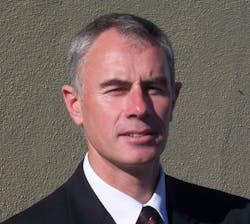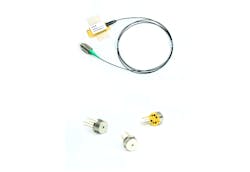For Jim Somers, CEO of Eblana Photonics, a company specializing in the design and production of laser diodes, career development comes down to embracing a unique professional journey. As he points out, individuals strive to have a deliberate, focused choice of their next steps, but then luck steps in and sets a different course, and sometimes, the best things come from those unexpected deviations. The journey, and how the individual responds to it, molds them into the leader they will become.
So, it may come as no surprise that as he reflects upon his own career in photonics, he wouldn’t change a thing. While Somers says that not every choice was perfect, the fact that he made them brought him to where he is today. Each decision has led him to his position as CEO of Eblana Photonics, a position he thoroughly enjoys.
Getting started in photonics
But where did it all begin? Somers goes back to his roots in Limerick, Ireland, where he received an undergraduate electronics engineering degree at what is now the University of Limerick, previously referred to as the National Institute for Higher Education. Known as both a strong business institution and for its engineering college, at the time, the University of Limerick was the only college in Ireland that focused on pure electronics as opposed to electrical engineering, which peaked Somers’ interests.
Somers did well in his program, and with graduation, began his search for the right first foray into his professional career in difficult economic times in Ireland. As luck would have it, he knew someone who worked at Verbatim Corporation who said they were hiring technicians and engineers, and he decided to give it a go. The company snatched him up, and Somers spent the first 14 years of his career in varying positions as he worked up the corporate ladder.
A triple threat
During his tenure at Verbatim, he explored a mixture of engineering, technical marketing, and sales—the triumvirate of business development in the photonics space. The ability to technically sell a product is a unique skill set—and one that Somers cultivated. In fact, he found the intersection of his passions in the marriage of technical understanding, marketing, and sales, and he was able to help support business and product development.
That knowledge then translated to new opportunities. When American electronics company Bourns Inc. was looking for a business development manager, Somers’ strengths uniquely fit the bill. He joined the company in 1997, and in just a few years’ time, became a general manager. He attributes this evolution to being able to cross various disciplines. While he understood technical details, he also could translate them to plain language and conversely, could extract out the specifics of client problems to help identify technical solutions.
According to Somers, at the highest level, every job has a degree of sales in it, whether it’s selling an idea to a boss, a timeline to teammates, or actually selling a product to a customer. As he reiterates, having the right mix of skills, knowledge, and passion makes all the difference in any of those scenarios and will ensure the greatest success.
Bursting bubbles
But as Somers is the first to identify, all the skills in the world can’t negate market volatility. So, when the tech bubble burst around 2001, he saw the need to pivot.
Working at Bourns in Ireland at the time, he witnessed a massive layoff and a transition in his own role, where he became responsible for a larger share of the company’s business. Where previously the emphasis was on telecom, now he was redirecting talent toward the non-telecom lines, like automotive and industrial solutions, to ride out the market downturn. He moved to California to lead the development of those business lines.
Under his leadership, the business unit started to see growth in those areas. And then in 2009, he felt the call to a new experience.
Pivot to survive
While it had been around for nearly a decade, Eblana Photonics was seeking a business leader. The company’s visionary founders had been trying to acquire the funding they needed to further develop their technology: They had been running development on a shoestring budget. According to Somers, when he came on board, the company had identified a couple of niche applications for their technology, but not enough to further develop at a fast rate.
So, it was then that Somers was charged with securing additional funding, but to do so, he also helped strategically direct the organization to pivot to new application areas outside of telecom, not divesting the telecom business, but rather, expanding the market horizons. That shift turned out to be the breath of life the company needed.
At that time, gas sensing was rising to be a critical area, and Somers helped the Eblana team position more aggressively in that space. In a relatively short period of time, they became known as the company to support that application space.
In addition, they started to raise their visibility as problem solvers. The Eblana team quickly realized they had an opportunity to demonstrate how valuable their technology was when a company needed a lot of different wavelengths and material systems. Word spread that if an organization wanted something unusual, they could come to Eblana, meet with the design team, and work toward a solution that fit unique parameters. Somers was able to find investors based on the need for unique lasers.
By developing and adding to this portfolio over the years, Somers modeled an approach that has taken the company to new levels. These changes ensured Eblana embarked upon a trajectory of growth and improvement, and in 2012, the company moved into profitability and has sustained it since.
Cycle of continuous improvement
But in the spirit of not resting on his laurels, Somers has been guiding further new directions for the Eblana team. Without a doubt, photonics has evolved over the last 10 years, and photonic techniques have become attractive for a wide range of solutions that were previously filled by more traditional technologies. But as demand grows for more advanced engineering for efficiency, accuracy, and cost-effectiveness, photonics has become a frontrunner—and Somers is making certain Eblana positions to support this shift.
Somers stresses the importance of being nimble and the company staying on its toes. They respond to the needs of the market by building a portfolio that aligns with the team’s knowledge and skillsets in a wide variety of industries. For instance, they are now working with a number of wind LiDAR companies as well as companies engaged in various quantum technology applications. They have med tech businesses as clients, who are exploring noninvasive techniques for evaluating elements in the blood from disease indicators to analytes for diabetics. Eblana is also working on more standard applications for laser diodes, including metrology and atomic clock applications for the European Space Agency.
Today’s business
All of this work is produced by a dedicated team of 30 people between their offices in Dublin and a small manufacturing unit in Taiwan. The Dublin operation oversees the design elements of the technologies, while Eblana conducts all of its own back-end processing and testing in Taiwan. With Asia being one of the biggest markets for the company, having a presence in Taiwan creates relationships that allow them to remain competitive in the space.
Overall, the company is focused on maintaining a wide portfolio of products. The ability to be able to produce lasers in a very broad wavelength range has opened doors with a lot of different companies, and the more unusual the wavelength, often the more advanced—and potentially profitable—the solution.
In many cases, volumes are small, but Eblana seeks out those with potential to expand. For example, Somers speaks of air quality monitoring around carbon dioxide and oxygen. Other wavelengths have very high-volume potential in certain use cases, like areas around natural gas pipelines, coal mines, in the case of methane monitoring etc. But looking ahead, Eblana projects growth in methane monitoring in homes: An ultra-low-cost methane sensor could be deployed in every home that has a gas hob or gas heating.
According to Somers, another example resides in the new healthcare parameters that exist in a post-COVID world. Air quality monitoring for schools, hospitals, office buildings, and homes will create a new generation of air quality management that may rely on photonic sensor technology.
He also points to home climate controls. Imagine a world with the ability to only bring on HVAC systems, or bring in fresh air at the moment when you need it and in the precise space it’s needed. It would be the difference of directing it into a specific area instead of utilizing today’s bulk approach for the whole entity.
In the end, these factors add up to potential, and that mindset is what’s driving Eblana Photonics’ evolution.
What the future holds
Eblana has been working to broaden its portfolio to address these and other emerging applications. A lot of technologies are grappling to solve similar problems, and with Somers’ leadership, Eblana plans to have a seat at the table, reiterating its ability to pinpoint and solve for unique needs.
Somers reflects that the company is able to pivot and scale as they do because they possess a small but mighty staff: More than half hold PhDs, because the company has invested in the skills of its people. And they are beginning to see the results of the early stage work they put in with startups over the past five years. Those companies are finding success in their own right, and Eblana is a big part of their growth stories.
So, for now, Eblana will continue with its philosophy of adding new products to meet specific customer needs. Somers feels by listening to the needs of the customer, they will find the right next step on their company path.
Following the dream
With a varied and successful career, Somers has a lot of wisdom to offer the next generation of photonics leaders. But when you ask him to reflect on his trajectory, Somers will tell you it’s the result of a lot of hard work and a lot of luck. As he says, he doesn’t know that he could have deliberately chosen another path. If he had chosen to leave Ireland and work abroad, for instance, he might be in a very different place than he is today. But the series of choices he has made have led him here, and it’s a good place to be.
His advice to young people? Follow your dreams, no matter where they lead. In contemplating how this next generation differs from his, he speaks to courage: Young photonics scientists, engineers, and business leaders are not afraid to leap into something new. He sees this generation as braver in some ways, seeking the road less traveled.
Somers sums up his career philosophy in one key sentiment: Most often, there’s no right or wrong path in one’s journey; they’re just different. Whether a person moves left or right, it will take them down a path of unique experiences that guide them on their journey to becoming future entrepreneurs, CEOs, and leaders. And in the end, that experience will shape their career trajectory and lead them to where they need to go.


